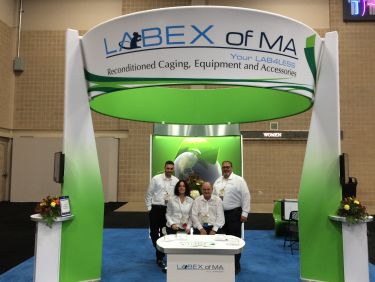
News & Events
Since You Asked...How can I get some of the equipment that I know big labs are getting rid of?

By Jack Metterville
Read the Article on alnmag.com
"We’re a small facility. How can I get some of the equipment that I know big labs are getting rid of?”
This question was sent in by a reader. With tight budgets and the ever increasing need to have equipment in keeping with current technology and at peak operation, there are probably many others who might be thinking the same thing.
In response to this question, we asked Jack Metterville, Vice President of Sales and Marketing for LABEX of MA, a supplier of quality reconditioned vivarium equipment, to provide some answers about buying used equipment.
How much can I expect to pay for used equipment as compared to new?
It should first be determined the condition and approximate age of the used equipment before requesting a price. You should consider only quality equipment which is either slightly used or has been maintained at a high level of conditioning and is appropriate for your intended use. You should ask for specification details of each item including photos. Please verify with your supplier that the equipment will be received in working condition with all components complete and with no rust or corrosion present. A reputable vendor should inspect, recondition, and clean each order, and quote prices approximately 50% the price of new.
What about leasing vs purchase?
In some instances, particularly when it can be determined the equipment is required only for a very short period of time, leasing can be an attractive alternative to purchasing. At times new equipment may be on order and the option to lease in the short term can help bridge this gap.As a general rule you can consider that leasing may be a reasonable option if you need the equipment for a period of less than six months, if longer than six months you should opt to buy the used equipment.
Are there warranties with used equipment?
You are buying used equipment, however, the expense can still be considerable and you should expect a warranty for any such purchase. Depending upon the type of product you purchase it should come with a minimum warranty of 30 days. It should be expected that this warranty states compete satisfaction for the products intended use for this period of time. The warranty should cover the return of the product for a credit or return of payments made. The buyer should give the vendor the option to repair or replace any broken or missing parts. A reputable vendor should have a policy to deliver 100% customer satisfaction or your money back.
What happens after the equipment arrives?
How should we expect to handle installation?
All purchases should be received complete, clean, and in good working order.Upon receipt at your location the buyer should perform an initial but careful inspection of the equipment received. Products delivered by an experienced vendor will be carefully palletized and/or packaged for transit. In the rare instance that damage has occurred, you have the right refuse the delivery. It is always recommended that you document the condition, take photos, and notify your vendor ASAP.
Depending upon the item you purchase, the best way to handle installation is to involve that company that you will be using to service the equipment in the future. In some cases this might involve the original manufacturer, a subcontractor specializing in the necessary install or certification, or your own facility’s support team. A reputable vendor can often assist with installation or make the appropriate referral for your consideration.
After the order has been received you should remove all packaging and again perform a careful inspection. For most vivarium equipment it will be immediately obvious that the condition is acceptable. It can be quickly determined that the all the components are included, no parts are missing, and the condition of the unit appears in working order. For those items with motorized components or requiring certification, those functions should be evaluated as soon as possible. Enough time in the warranty should be agreed to in order to reasonably perform these evaluations. At LABEX of MA we load and secure each of our orders ourselves onto the delivery trucks and use “air ride” services to protect our most fragile items—this level of service should be expected.
And what about repairs?
Any necessary repairs required due to the delivery process are the responsibility of the vendor. Any repairs required during the warranty period due to normal use are the responsibility of the vendor. The vendor should be willing and able to work with the buyer to make all necessary repairs quickly. This may involve the vendor making the repairs, the vendor directing the repairs with the client, or subcontracting for the repairs. A reputable vendor will make the need for repairs as painless and quickly as possible.
Anything else we should know?
The best and most efficient way to get unwanted equipment is to consult with a reputable company. The absolutely most important thing when buying used equipment is that you can trust your vendor. Your vendor should be familiar with the purpose and the use of the equipment you are inquiring about. Most caging and accessory equipment in most circumstances must meet certain regulatory guidelines and your vendor should be familiar with these requirements as well. There is nothing like trust in a vendor/buyer relationship. Get to know your vendor, get to trust your vendor, discuss all the “what ifs” and you won’t have to be thinking “it's too good to be true.”
WE ARE DEDICATED TO PROVIDING THE HIGHEST QUALITY USED AND RECONDITIONED ANIMAL CAGES
AND ACCESSORIES TO OUR RESEARCH PARTNERS WORLD-WIDE








Follow Us On: